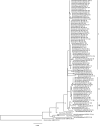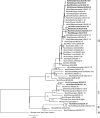Molecular epidemiology of mumps viruses in the Netherlands, 2017-2019
- PMID: 32925979
- PMCID: PMC7489541
- DOI: 10.1371/journal.pone.0233143
Molecular epidemiology of mumps viruses in the Netherlands, 2017-2019
Abstract
Mumps cases continue to occur, also in countries with a relatively high vaccination rate. The last major outbreaks of mumps in the Netherlands were in 2009-2012 and thereafter, only small clusters and single cases were reported. Molecular epidemiology can provide insights in the circulation of mumps viruses. The aims of the present study were to analyze the molecular epidemiology of mumps viruses in the Netherlands in 2017-2019 and to compare the phylogenetic trees built from sequence data of near complete mumps virus genomes or from the SH gene and non-coding regions (SH+NCRs). To this end, Sanger sequence data from SH+NCRs were analyzed from 82 mumps genotype G viruses. In addition, near complete genomes were obtained from 10 mumps virus isolates using next-generation sequencing. Analysis of SH+NCRs sequences of mumps genotype G viruses revealed the presence of two major genetic lineages in the Netherlands, which was confirmed by analysis of near complete genomes. Comparison of phylogenetic trees built with SH+NCRs or near complete genomes indicated that the topology was similar, while somewhat longer branches were present in the phylogenetic tree with near complete genomes. These results confirm that analysis of SH + NCRs sequence data is a useful approach for molecular surveillance. Furthermore, data from recent mumps genotype G viruses might indicate (intermittent) circulation of mumps genotype G viruses in the Netherlands in 2017-2019.
Conflict of interest statement
The authors have declared that no competing interests exist.
Figures



References
MeSH terms
Substances
LinkOut - more resources
Full Text Sources
Medical

